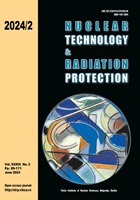
AN APPROACH BASED ON GAMMA-RAY TRANSMISSION TECHNIQUE AND ARTIFICIAL NEURAL NETWORK FOR ACCURATELY MEASURING THE THICKNESS OF VARIOUS MATERIALS
Pages: 98-110
Authors: Le Thi Ngoc Trang, Nguyen Thi Truc Linh, Tran Thien Thanh, Hoang Duc Tam, and Huynh Dinh ChuongAbstract
This paper presents an approach based on the gamma-ray transmission technique and artificial neural network for accurately measuring the thickness of various materials in flat sheet form. The gamma-ray transmission system comprises a NaI(Tl) scintillation detector coupled with a 137Cs radioactive source. The artificial neural network model predicts the sample thickness through three input features: mass density, linear attenuation coefficient, and ln(R) – where R represents the ratio of areas under the 662 keV peak in spectra acquired from measurements with and without the sample. The artificial neural network model was trained using simulation data generated by MCNP6 code, facilitating the creation of comprehensive datasets covering diverse material types and thickness variations at a low cost. Hyperparameters of the artificial neural network model were defined by several optimization methods, such as hyperband-bayesian, tree-structured Parzen estimator, and random search, to establish an optimal artificial neural network architecture. Subsequently, the optimal artificial neural network model was deployed to predict the thickness of graphite, aluminum, copper, steel, and polymethyl methacrylate sheets, using input data obtained from the experiments. The results showed a good agreement between predicted and reference thicknesses, with a maximum relative deviation of 1.94 % and an average relative deviation of 0.52 %.
Key words: artificial neural network, flat sheet, gamma-ray transmission, thickness measurement
FULL PAPER IN PDF FORMAT (1,51 MB)
